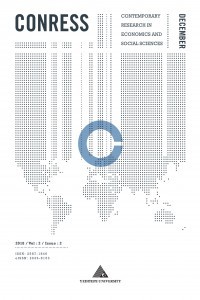Some Equity in Tax Collections of the Government in a Commodity Market
Some Equity in Tax Collections of the Government in a Commodity Market
Laffer effect, a commodity market, optimal ad valorem tax rate, non-linear model consumers’ share of burden of tax,
___
- Agell, J. and M. Persson (2001). On the Analytics of the Dynamic Laffer Curve. Journal of Monetary Economics, 48, 397–414.
- Bruce, N. and S.J. Turnovsky (1999). Budget Balance, Welfare and the Growth Rate: Dynamic Scoring. Journal of Money, Credit and Banking, 31, 162–186. Ireland, P. N. (1994). Supply-side Economics and Endogenous Growth. Journal of Monetary Economics, 33, 559-571.
- Mas-Colell, A.,Whinston, M. D. and J. R. Green (2004). Microeconomic Theory, Oxford University Press.
- Özçam, A. and D. S. Özçam (2012). Construction of Price Indexes for different Segments of Automobiles in Turkish Market and Estimation of Varying Price Elasticities. 7thAnnual International Symposium on Economic Theory, Policy and Applications, ATINER, 23-26 July 2012, Athens, Greece.
- Özçam, A. (2014). Should Before or After Tax Equilibria Point Elasticities be Calculated When the Laffer Effect is Considered in a Micro Market? Journal of Economic Studies, 41(6), 754-770.
- Özçam, A. (2015). The Laffer Effect in a Product’s Market in the Case of a Specific Tax. Review of Economics and Finance, 5(1), 85-99.
- Perloff, J, M. (2008). Microeconomics Theory and Applications with Calculus, Pearson Addison Wesley, International edition.
- Varian, H. R. (1999). Microeconomic Analysis, New York: W. W. Norton & Company.
- ISSN: 2587-1846
- Başlangıç: 2017
- Yayıncı: Yeditepe Üniversitesi
Pınar YAZGAN, M. Murat YÜCEŞAHİN, Sevim ATİLA DEMİR
Some Equity in Tax Collections of the Government in a Commodity Market
The Impact of the Global Financial Crisis on the Economic Development in the Eurasian Region
The Established and The Outsiders-Theorem Instead of ‘‘Racism’’: A Figuration of Power Assymmetrie
18 Mart 2016 Tarihli AB-Türkiye Zirvesi Bildirisinin Hukuki Niteliği
The Evolution of British Commercial Diplomacy in the Ottoman Empire
‘Action of Violence’ or ‘Democratic Protest’? According to the Turkish Press Gezi Park Resistance
